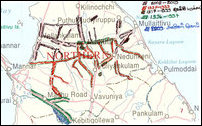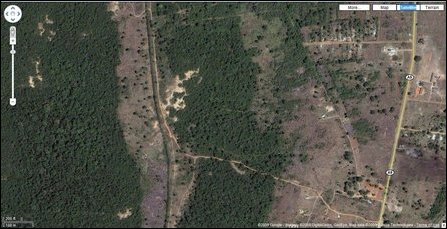
Global meet urged to discuss environmental genocide by Sri Lanka
[TamilNet, Friday, 04 December 2009, 13:18 GMT]
Decades-long massive military operations and occupation of Tamil Eelam by Sri Lankan forces have caused grave environmental destruction to the north and east of the island. Recovery is difficult as the Tamil homeland is in the dry and arid part of the island, depending on scanty and truant northeast monsoon, writes environmentalist and freelance journalist T. Thipaakaran. It may take more than 150 years for the plundered timber trees to grow again, he says. Tamil academic circles viewing the situation as 'ethnically motivated environmental rape taking place with international abetment,' urge the Denmark meet to discuss the challenge of curbing such crimes of ‘state sovereignty’ and to explore ways of entrusting in such situations the control of land to the sons and daughters of the soil, who only could take a genuine interest in the recovery and protection of their environment.
Genocide is a multifaceted affair for States such as Sri Lanka that has taken it as an obsession for decades. Genocide carried out by such States encompasses every aspect of life of the victims and it goes without saying that deliberate and systematic damage to environment is a main device.
Sri Lanka has now accelerated the use of the environmental weapon, as the so-called international community and international organisations have given a ‘blank cheque’ to it in the conquest and in the management of the conquered territory of Tamils.
The Copenhagen-based formation committee of Denmark Council of Eezham Tamils and British Tamil Forum (BTF) will bring the issue to the notice of global environmental meet in Denmark, next week.
Meanwhile, promoting the environmental cause of Eezham Tamils, two Tamil environmentalists from Tamil Nadu, India, Mr. T. Srinivasa Rao, 48, with his family and R. Gnanasekaran, 46, will be in Denmark for the global meet. They, for several years now, are on a global tour promoting environmental awareness and have been covering 600,000 km since 1986 visiting 120 countries and attended both the previous UNFCC summits.

T. Thipaakaran
Writing on the devastation of the environment of Eezham Tamils, freelance journalist Thipaakaran, now based in London, says that while the damage to the East is still unaccounted, what happened to the north could be roughly made out because of the drastic nature of the destruction.
Thipaakaran was earlier trained to become a schoolteacher in agro-science and his interest in environment stems from his student days at Palaali Teachers Training College.
He brings out details of several thousands of acres of forest cover in the north that has been cleared by Sri Lanka’s military since 1996, adding that more serious damages have taken place in an accelerated way in the recent war. A comprehensive assessment of the latter is not possible due to military occupation of the region, he says.
In the 2000-2004 period, the Tamil Eelam civil administration, under the LTTE, took care of afforestation. But even those forests are now destroyed by the military, Mr. Thipaakaran said.

The pattern of destruction of forest on either side of the roads to provide security to the military during various military operations between 1996 and 2009, illustrated by Mr. Thipaakaran
The forests were recklessly destroyed by more than a hundred thousand soldiers deployed in Vanni, to make camps, artillery bases, bund protections, roads and cleared protection strips on either side of the roads. The destruction of forests and the creation of security zone bunds in many places have affected the catchment areas of streams and reservoirs. The damage to forest animals is beyond all accounts.
In the recent war, artillery firepower used by Colombo’s troops and aerial bombing destroyed not only forests but also domestic trees of food value.
According to a 2004 statistics, 12,000 coconut palms in Mukamaalai area were cut for the use of the military.
Valuable timber trees were particularly plundered by the military officials and were smuggled out of the war zone. Even now some influential sections continue committing the crime in the military occupied territory, says Thipaakaran.

Manik Farm internment camp [Satellite Image: Google Earth]
By the end of the war, several thousand of acres of forests were cleared for the internment camps. A prime forest between Aruviyaa’ru River and A 14 highway was cleared for one such camp.

The extent of deforestation for the Manik Farm IPD camp in the prime forest area between Aruvi Aa'ru and A14 Highway. [Satellite Image: Google Earth]
The proposed military cantonments and other military installations in the north, besides exploitation programmes in the name of ‘development’ are going to be permanent environmental hazards, Tamil circles fear.
![T. Srinivasa Rao [Left] and R. Gnanasekaran](/img/publish/2009/12/Srinivasan_Gnanasekaran_83988_200.jpg)
T. Srinivasa Rao [Left] and R. Gnanasekaran [Right]

Srinivasan's family on global warming campaign tour
The glee with which thousands and thousands of palmyra palms, considered to be the symbol of the people of Jaffna, were cut by the 40,000 strong occupying Sinhala troops in the peninsula to make fortifications, is just one example of the ethnically motivated attitude of environmental damage, Tamil circles point out.
A major problem with the international agencies such as the UN, institutions of the international community and donor agencies meant for the protection of environment, is that their human resource development programmes, training of personnel or higher educational and research opportunities go only to the very people who commit the environmental genocide.
The people of the victim nations and their academics or students are never benefited as opportunities are always channelled through the ‘State.’ Once again the victims are put at the mercy of their ‘trained’ oppressors for any remedy.
IC and UN have to seriously think of directly selecting people for providing knowledge, by-passing State in situations such as Sri Lanka, if they really care for results.
During recovery programmes, natural forests of variety getting replaced by monotonous afforestation of select commercial varieties, is another tragedy for environment, said an academic in Vavuniyaa. "Market economy is not the guiding spirit for comprehensive environmental protection. Local knowledge of flora needs to be tapped fully, to bring back the variety and pristine glory of our forests," he said.

A strip of road at Pu'liyangku'lam: An example of the clearance of forest in either side of the bund and road to provide security to the military.












![T. Srinivasa Rao [Left] and R. Gnanasekaran](/img/publish/2009/12/Srinivasan_Gnanasekaran_83988_200.jpg)

